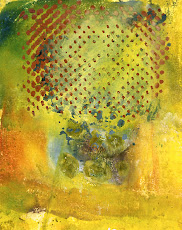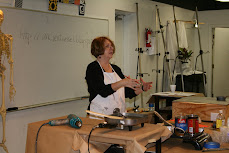 People have been painting with it off-and-on for centuries dating back to Ancient Egypt, Greece and Rome. Here in Houston at the Menil Museum you can see several Fayum Mummy Portraits that date to antiquity.
People have been painting with it off-and-on for centuries dating back to Ancient Egypt, Greece and Rome. Here in Houston at the Menil Museum you can see several Fayum Mummy Portraits that date to antiquity.My dictionary sources describe it as:
- A paint consisting of pigment mixed with beeswax and fixed with heat after its application.
- The art of painting with this substance.
- A painting produced with the use of this substance.
[Latin encausticus, from Greek enkaustikos, from enkaiein, enkau-, to paint in encaustic : en-, in; see en-2 + kaiein, to burn.]
Contemporary artists such as Jasper Johns and Kay Walking Stick have been using the medium in their paintings for the past several decades. The medium has risen in popularity recently with many artists adding it to their repertoire on their own or through the many workshops popping up around the country.
RF Paint Store in Kingston, NY is one such place offering workshops as well as a large selection of Encaustic painting supplies that they make at this location. At their on-line store you can not only order supplies but participate in the Encaustic Forum where you can find the answer to almost any question about this medium from how to make it to how to ship paintings made with it.
Paula Roland, an artist who lives and works in New Mexico has been instrumental in developing print making techniques in the medium and shares her knowledge through her workshops in Santa Fe.

Print-making with wax is a simple process that doesn't require large and expensive equipment. The printing plate that I use is fashioned after the one designed by Paula Roland.
It is essentially a hot plate---an open wooden box topped with a flat anodized aluminum plate. Four 100-watt light bulbs connected to a rheostat inside the box provide the heat.
In this process, the encaustic paint is then used to draw onto the hot plate. The paper is then placed on top of the melted wax design and pressed into the wax gently with a barren. After the paper is pulled from the plate and the paper cools, it can be deemed finished or the process can be repeated several times for additional layers. Although it is a rather serendipitous medium, one is able to achieve more control by understanding the responsiveness of the different kinds of paper and through regulation of temperature.
For printing I keep the hot plate heated to around 170 degrees for most printing jobs depending on the paper.
According to Joanne Mattera, the optimum range for painting is 165 to 220 degrees. Temperatures above 250 degrees weaken and discolor the wax.
Her book, The Art of Encaustic Painting: Contemporary Expression in the Ancient Medium of Pigmented Wax is a great source for those interested in working in the encaustic medium.I use an electric griddle for my palette and heat gun as my fusing tool. Some artists prefer a propane torch like the ones you use in the kitchen. Of course, you can find nicer palette's at RF Paint store or at any of the several others around the country like Fine Art Store or Evans Encaustics.Why Wax?
Initially, I was drawn to the wax medium through printmaking. The idea that I could make mono-types without all the expensive equipment was the draw. I attended an Encaustic mono-type workshop with Paula Roland in Sante Fe several years back where she included two days of encaustic painting instruction in the five day workshop. I was hooked.
I am drawn to the versatility of the medium---textured, smoothe, translucent, opaque, paint, glue, 2-D or 3-D, and it goes on and on. Many artists love it because of the natural fragrance of the beeswax. I like that too.
I guess what I like best is that it satisfies a desire to use a medium that is a natural, organic product.



